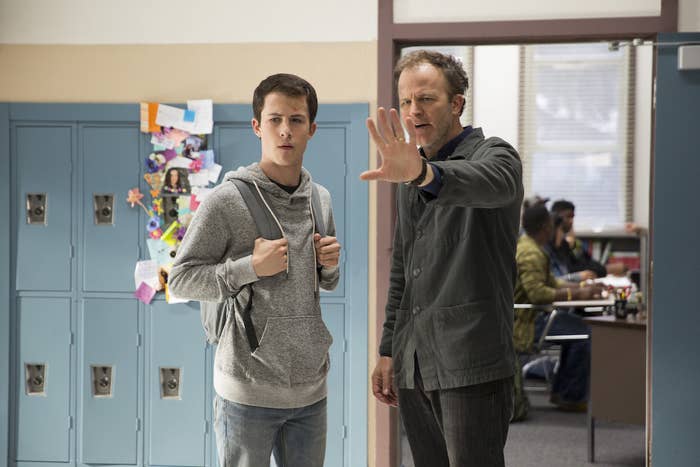
When Netflix released its massively popular 13 Reasons Why — which centers on a fresh-faced high school girl who kills herself and leaves messages for classmates she holds responsible — the show sparked a heated debate over whether it would romanticize teen suicide. So when a new scientific study was published that showed an uptick in suicide rates for young people after the series debuted in 2017, the headlines were damning and critics claimed validation.
But mental health experts say people should be aware that it’s more complicated than a simple headline might imply.
“This is sort of the culmination of a series of reports that seem to corroborate some of the concerns that many of us expressed when the show came out. But again, obviously, with any of these things, it’s always difficult to prove causation,” Victor Schwartz, medical director at the Jed Foundation, a nonprofit organization that focuses on mental health and suicide prevention for teens, told BuzzFeed News.
Last week the Nationwide Children’s Hospital published a new study in the Journal of the American Academy of Child and Adolescent Psychiatry that found there was a 28.9% increase in suicide rates among boys ages 10 to 17 in the US in April 2017, one month after 13 Reasons Why debuted. Over the nine-month period following the show’s debut, researchers also said there were nearly 200 more suicides than expected.
The findings prompted a wave of news articles and concern on social media. But missing from the headlines were important caveats: Researchers did not know if anyone who died had watched the show, and they used a forecasting model to predict what suicide rates should have been that relied on small numbers, which are prone to wide variations.
Basically, the study determined correlation, not causation.
“It’s certainly a curious association, and it looks like the analysis they did in the study was pretty thoughtful,” Schwartz said. “It really shows that something happened that April that was different from other Aprils. It might not be the show, it might be something environmental, but there’s no other obvious thing that’s changed.”
Another finding: The increase in April was only attributable to suicides among boys, not girls, which is curious, given that the main character who kills herself in 13 Reasons Why is a teen girl.

Another recent study from the University of Pennsylvania found that students who watched the entire second season were less likely to harm themselves on purpose or to seriously consider suicide.
Dan Romer, coauthor of that study, told BuzzFeed News he was surprised by some of its more positive findings. According to Romer, the study showed that people went online and looked up information after completing the second season of 13 Reasons Why to learn more about topics covered in the show, including suicide and sexual abuse.
“We didn’t quite expect that getting through the whole thing would be beneficial for anybody,” Romer said.
Over the past two years, there have been numerous studies on 13 Reasons Why and its potential impact on viewers, including one last year by Northwestern’s Center on Media and Human Development that was commissioned by Netflix after the show’s controversial first season.
But experts say the sheer volume of research can make it difficult for readers to navigate and get a clear picture of what the data actually shows.
“People tend to sort of read the headline and jump to some kind of conclusion, when these things are really complicated,” Schwartz said.
Myles McNutt, a media studies scholar and assistant professor of communication and theater arts at Old Dominion University, told BuzzFeed News that the trend of studies about 13 Reasons Why is reflective of a “desire to be topical.” Even though he thinks we should be asking questions about depictions of suicide on TV, especially when the program is aimed at teenagers, McNutt said the studies are usually designed to make headlines.
“Are people writing about this show because they think it makes their research more relevant, or are they doing it because they actually care about thinking about media representations of suicide?” McNutt said. “A lot of these studies are really talking about something complex with suicide, and the results are not really just focused on 13 Reasons Why, but they’re being pinned to 13 Reasons Why as a way of sort of expanding their visibility.”
The trend has also caught the attention of Helen Hsu, a licensed clinical psychologist in California who has served as a mental health consultant of sorts for the show since Season 1.
“One study will come out, and it’s fascinating for me to see how, within a day, almost every major news outlet I see on my feed is on it,” she said.
While Hsu thinks critical analysis in general is good, she said that throwing information out there when the average reader might not know how to analyze it can be dangerous.
“Everybody wants a simple answer for a very complex social problem,” she said. “By definition, studies narrow it down to one or two factors and they try to study it, but it leaves out important things.”
Hsu is more concerned about access to mental health resources, funding for those resources in schools, and the ability of young people to communicate openly with their parents, because “art and entertainment are just one piece of the problem.”
“My main fear is that people will just spend all their time and energy not addressing the things that really matter,” she added.

Schwartz, who’s long been an advocate for responsible entertainment content in the portrayal of suicide, said that despite all the data — some of which is concerning — he’s not confident that it reaches people the same way the Netflix series does.
“I don’t know that the impact of the studies is greater than the impact of the show,” he said.
Netflix, which did not respond to BuzzFeed News’ requests for comment, told Digital Spy it was looking into the data, but noted differences between the Nationwide Children’s Hospital’s findings and those of UPenn.
"We've just seen this study and are looking into the research, which conflicts with last week's study from the University of Pennsylvania,” a spokesperson said. “This is a critically important topic, and we have worked hard to ensure that we handle this sensitive issue responsibly."
Netflix also has a website, 13reasonswhy.info, dedicated to resources on suicide prevention, with individual video messages from cast members. (The third season is expected to air sometime in 2019.)
For her part, Hsu said Netflix has a “very strong commitment to try to do things responsibly," including tasking someone with analyzing and monitoring research about the show.
“Nobody’s randomly doing this show for shock value,” Hsu said. “I think we all feel really strongly that stigma has to be broken and these things have to be talked about.”
The National Suicide Prevention Lifeline is 1-800-273-8255. Other international suicide helplines can be found at befrienders.org.
